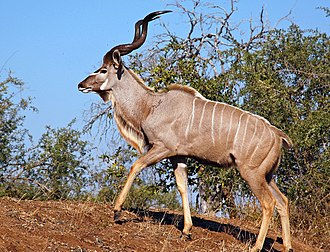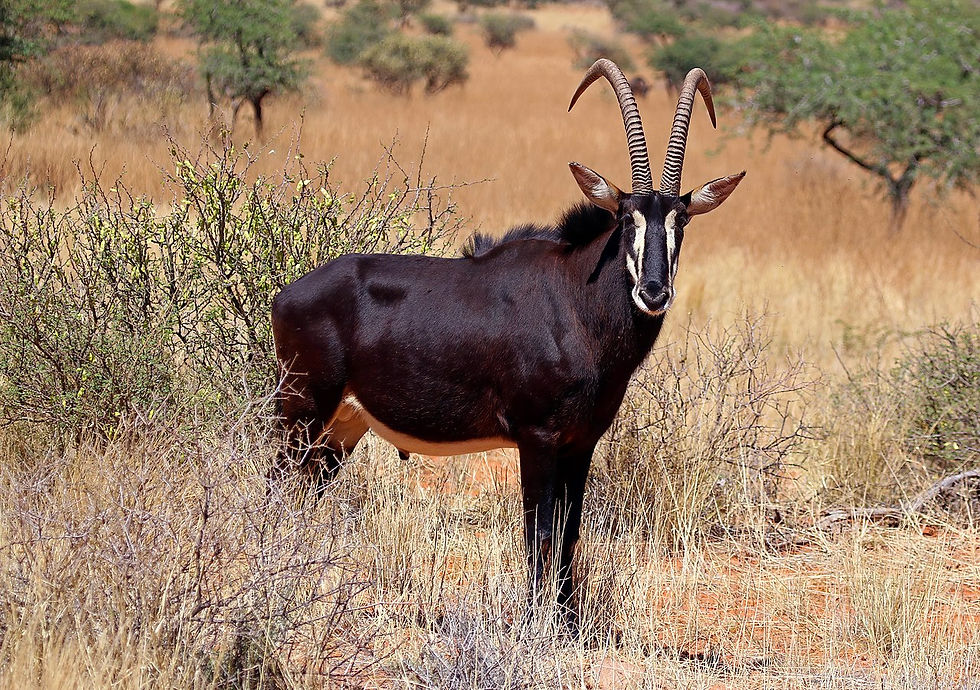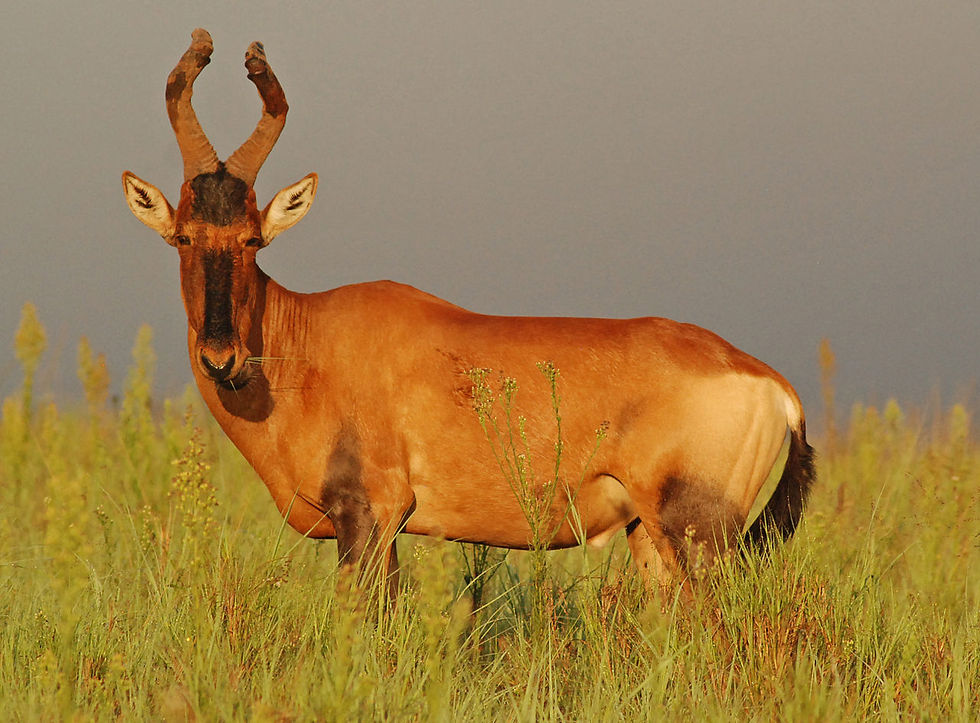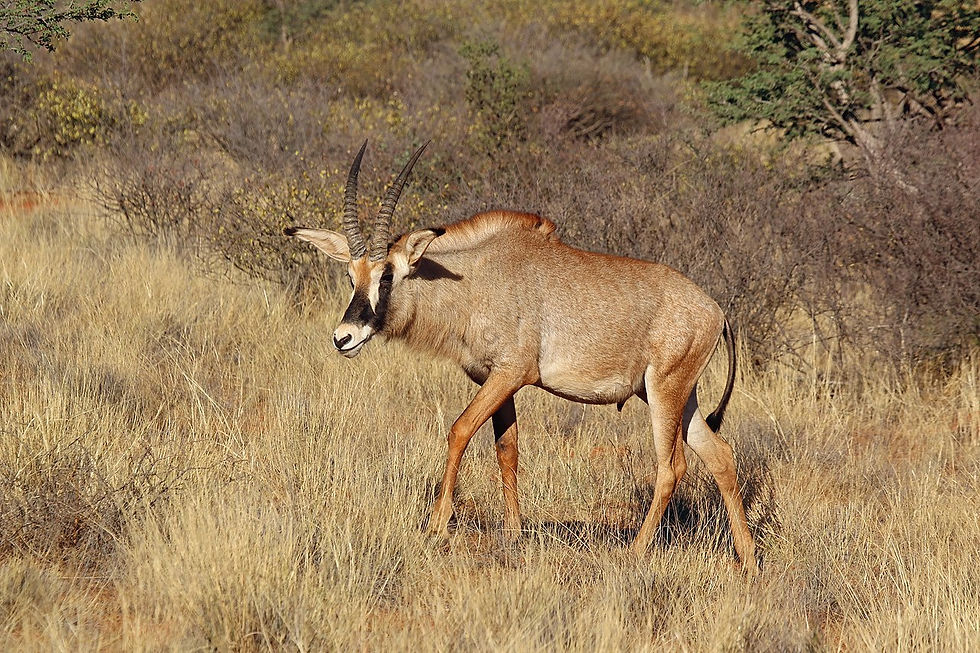ANTELOPE OF
SOUTHERN
AFRICA
Antelope are swift-running deerlike ruminant with smooth hair and upward-pointing horns, of a group native to Africa and Asia that includes the gazelles, impala, gnus, and elands. Images, links and information to the following animal cards are provided for by www.wikipedia.org and through our own images and descriptions.
GREATER KUDU
@Southern/Eastern Africa



#Tragelaphus strepsiceros , The greater kudu is a woodland antelope found throughout eastern and southern Africa. Despite occupying such widespread territory, they are sparsely populated in most areas due to declining habitat, deforestation, and poaching. The greater kudu is one of two species commonly known as kudu, the other being the lesser kudu, T. imberbis.
BLESBOK
@Southern Africa


#Damaliscus pygargus pygargus , The blesbok and the bontebok are subspecies of the same species and can readily interbreed, the hybrid offspring being known as the bontebles or baster blesbok; the differences between the two subspecies have arisen due to preferences for different habitats in the wild. The blesbok is endemic to southern Africa and is found in large numbers in all national parks with open grasslands
LICHTENSTEIN'S HARTEBEEST
@Southern/Eastern Africa


#Alcelaphus buselaphus lichtensteinii , a subspecies of the hartebeest antelope that dwells in savannahs and floodplains of Southeastern[3]-Central Africa. It is sometimes classified as a unique species Sigmoceros lichtensteinii. It has a red-brown colour, which is lighter on the underbelly.
BLUE DUIKER
@Southen/Central/Eastern Africa



#Philantomba monticola , A small antelope found in central, southern and eastern Africa. It is the smallest duiker. 12 subspecies are identified. The blue duiker reaches 32–41 centimetres (13–16 in) at the shoulder and weighs 3.5–9 kilograms (7.7–19.8 lb). Sexually dimorphic, the females are slightly larger than the males.
GREY DUIKER
@Africa




#Sylvicapra grimmia , Also known as the grey or bush duiker, is a small antelope found everywhere in Africa south of the Sahara, excluding the Horn of Africa and the rainforests of the central and western parts of the continent. Generally, they are found in habitats with sufficient vegetation cover to allow them to hide—savanna and hilly areas, including the fringes of human settlements.
KLIPSPRINGER
@Eastern/Southern Africa




#Oreotragus oreotragus , A small antelope being the sole member of its genus. The klipspringer is a small, sturdy antelope; it reaches 43–60 centimetres (17–23+1⁄2 inches) at the shoulder and weighs from 8 to 18 kilograms (18 to 40 pounds). The coat of the klipspringer, yellowish gray to reddish brown, acts as an efficient camouflage in its rocky habitat.
ORIBI
@Africa




#Ourebia ourebi , A small antelope found in eastern, southern and western Africa. The sole member of its genus. Eight subspecies are identified. It possesses a slightly raised back, and long neck and limbs. The glossy, yellowish to rufous brown coat contrasts with the white chin, throat, underparts and rump. Only males possess horns; the thin, straight horns.
CAPE GRYSBOK
@South Africa


#Raphicerus melanotis , The Cape or southern grysbok is a small antelope that is endemic to the Western Cape region of South Africa between Albany and the Cederberg mountains. It has a rough, reddish sandy coat flecked in white. The head, neck and legs are less flecked and somewhat yellowish, while the inside of the ears, eye-rings, mouth area, throat and underside are white.
SUNI
@South Eastern Africa


#Nesotragus moschatus , A small antelope. It occurs in dense underbrush from central Kenya to
KwaZulu-Natal in South Africa.
Suni are around 30 to 43 centimetres (12 to 17 inches) high at the shoulder and weigh 4.5 to 5.4 kilograms (9 lb 15 oz to 11 lb 14 oz). They are usually reddish brown, darker on their back than their sides and legs. The belly, chin, throat and insides of legs are white.
GREY RHEBOK
@South Africa




#Pelea capreolus , The grey rhebok or grey rhebuck , locally known as the reebok in Afrikaans, is a species of antelope native to South Africa, Lesotho, and Eswatini (Swaziland). The specific name capreolus is Latin for 'little goat'. The grey rhebok is a medium-sized antelope with a long neck and narrow ears. The coat is short and dense and coloured in various shades of grey.
SABLE ANTELOPE
@Eastern and Southern Africa




#Hippotragus niger , The sable antelope is an antelope which inhabits wooded savanna in East and Southern Africa, from the south of Kenya to South Africa, with a separate population in Angola.
SITATUNGA
@Central Africa



#Tragelaphus spekii , The sitatunga or marshbuckis a swamp-dwelling antelope found throughout central Africa, centering on the Democratic Republic of the Congo, the Republic of the Congo, Cameroon, parts of Southern Sudan, Equatorial Guinea, Burundi, Ghana, Botswana, Rwanda, Zambia, Gabon, the Central African Republic, Tanzania, Uganda and Kenya.
CAPE BUSHBUCK
@Sub-Saharan Africa




#Tragelaphus scriptus , A common and a widespread species of antelope in Sub-Saharan Africa. Bushbuck are found in a wide range of habitats, such as rain forests, montane forests, forest-savanna mosaic, savanna, bushveld and woodland. They are generally solitary, territorial browsers.
SOUTHERN REEDBUCK
@Southern Africa



COMMON ELAND
@Eastern/Southern Africa




#Taurotragus oryx , also known as the southern eland or eland antelope, is a savannah and plains antelope found in East and Southern Africa. It is a species of the family Bovidae and genus Taurotragus. An adult male is around 1.6 metres (5') tall at the shouldeand can weigh up to 942 kg (2,077 lb) It is the second largest antelope in the world, being slightly smaller on average than the giant eland of North Africa.
LECHWE
@South Central Africa




#Kobus leche , The lechwe , red lechwe or southern lechwe, is an antelope found in wetlands of south central Africa. The lechwe is native to Botswana, Zambia, southeastern Democratic Republic of Congo, northeastern Namibia, and eastern Angola, especially in the Okavango Delta, Kafue Flats, and Bangweulu Wetlands.
BONTEBOK
@Southern Africa




#Damaliscus pygargus pygargus , The bontebok is a subspecies of Damaliscus pygargus, an antelope found in South Africa, Lesotho and Namibia. Damaliscus pygargus pygargus has two subspecies; the bontebok occurring naturally in the Fynbos and Renosterveld areas of the Western Cape, and the blesbok occurring in the Highveld.
RED HARTEBEEST
@Southern Africa




#Alcelaphus buselaphus caama , Also known as the Cape hartebeest is a subspecies of the hartebeest found in Southern Africa. More than 130,000 individuals live in the wild. The red hartebeest is closely related to the tsessebe and the topi.
COMMON TSESSEBE
@Africa



#Damaliscus lunatus , Also known as the topi, sassaby tiang or tsessebe. A large African antelope of the genus Damaliscus and subfamily Alcelaphinae in the family Bovidae, with a number of recognised geographic subspecies. Some authorities have split the different populations of the species into different species although this is seen as controversial
RED FOREST DUIKER
@Southern Africa


#Cephalophus natalensis , The red forest duiker, Natal duiker, or Natal red duiker is a small antelope found in central to southern Africa. It is one of 22 extant species form the subfamily Cephalophinae. While the red forest duiker is very similar to the common duiker, it is smaller in size and has a distinguishing reddish coloring. Additionally, the red forest duiker favors a denser bush habitat than the common duiker.
SPRINGBOK
@South Western Africa




#Antidorcas marsupialis , A medium-sized antelope found mainly in southern and southwestern Africa. The sole member of the genus Antidorcas, this bovid was first described by the German zoologist Eberhard August Wilhelm von Zimmermann in 1780. Three subspecies are identified. A slender, long-legged antelope,
DAMARA DIK-DIK
@South East/South West Africa




#Madoqua kirkii , A small antelope native to Eastern Africa and one of four species of dik-dik antelope. It is believed to have six subspecies and possibly a seventh existing in southwest Africa. Dik-diks are herbivores, typically of a fawn color that aids in camouflaging themselves in savannah habitats. According to MacDonald (1985), they are also capable of reaching speeds up to 42 km/hour.
STEENBOK
@Southern and Eastern Africa



#Raphicerus campestris , A common small antelope of southern and eastern Africa. It is sometimes known as the steinbuck or steinbok. Steenbok resemble small Oribi, standing 45–60 cm (16"–24") at the shoulder, and average ~12kg. Their pelage (coat) is any shade from fawn to rufous, typically rather orange. The underside, including chin and throat, is white, as is the ring around the eye.
SHARPE'S GRYSBOK
@South Eastern Africa



#Raphicerus sharpei , Sharpe's or northern grysbok is a small, shy, solitary antelope that is found from tropical to south-eastern Africa. It is similar in size to the gray duiker, but has a stockier body and elongated fur over the hindquarters. The males have stubby horns, which are widely spaced. Sharpe's grysbok has a short deep muzzle with large mouth and heavy molar (grinding) teeth.
IMPALA
@Southern Eastern Africa



#Aepyceros melampus , A medium-sized antelope found in eastern and southern Africa. The sole member of the genus Aepyceros, it was first described to European audiences by German zoologist Hinrich Lichtenstein in 1812. Two subspecies are recognised—the common impala, and the larger and darker black-faced impala.
ROAN ANTELOPE
@Africa




#Hippotragus equinus , A savanna antelope found in western, central, and southern Africa. one of the largest species of antelope; only eland, bongo and large male greater kudu can exceed them in weight. They are similar in appearance to the sable antelope and can be confused where their ranges overlap. Sable antelope males are darker, being brownish-black rather than dark brown.
GEMSBOK
@South West Africa




#Oryx gazella , The gemsbok, gemsbuck or South African oryx (Oryx gazella) is a large antelope in the genus Oryx. It is native to the arid regions of Southern Africa, such as the Kalahari Desert. Some authorities formerly included the East African oryx as a subspecies.
NYALA
@Southern Africa




#Tragelaphus angasii , The lowland nyala or simply nyala is a spiral-horned antelope native to southern Africa (not to be confused with the endangered Mountain nyala living in the Bale region of Ethiopia). It is a species of the family Bovidae and genus Nyala, also considered to be in the genus Tragelaphus.
MOUNTAIN REEDBUCK
@Sub-Saharan Africa




#Redunca fulvorufula , The mountain reedbuck occurs in three separate geographic areas, each containing a separate subspecies. The southern mountain reedbucks inhabits an area from the eastern Cape Province (South Africa) to southeastern Botswana. Chanler's mountain reedbuck occurs in Tanzania, Kenya, Uganda, Sudan, and Ethiopia.
BOHOR REEDBUCK
@Central Africa



#Redunca redunca , The bohor reedbuck prefers grasses and tender reed shoots with high protein and low fiber content. This reedbuck is dependent on water, though green pastures can fulfill its water requirement. The social structure of the bohor reedbuck is highly flexible. Large aggregations are observed during the dry season, when hundreds of bohor reedbuck assemble near a river.
WATERBUCK
@Sub-Saharan Africa




#Kobus ellipsiprymnus , A large antelope found widely in sub-Saharan Africa. It is placed in the genus Kobus of the family Bovidae. Its 13 subspecies are grouped under two varieties: the common or ellipsiprymnus waterbuck and the defassa waterbuck. Waterbucks are rather sedentary in nature. As gregarious animals, they may form herds consisting of six to 30 individuals.
PUKU
@Southern Africa




#Kobus vardonii , A medium-sized antelope found in wet grasslands in southern Democratic Republic of Congo, Namibia, Tanzania, and Zambia.[1] Nearly one-third of all puku are found in protected areas, zoos, and national parks due to their diminishing habitat. The puku is sandy brown in colour, with the underbelly a slightly lighter brown. The coat is rougher than the similar-sized southern reedbuck, lechwe or impala, or the smaller oribi







.png)

.png)
.png)
